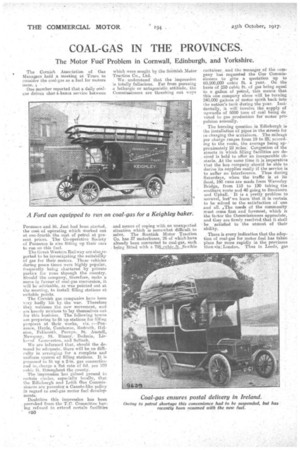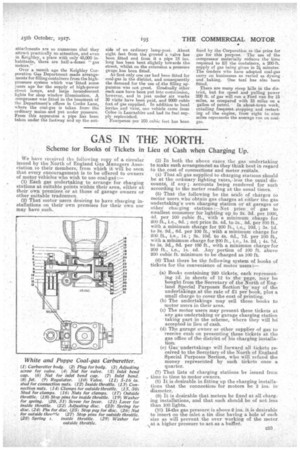COAL-GAS IN THE PROVINCES.
Page 16

Page 17

If you've noticed an error in this article please click here to report it so we can fix it.
The Motor Fuel" Problem in Cornwall, Edinburgh, and Yorkshire.
The Cornish Association of Gas Managers held a meeting at Truro to consider the coal-gas as a fuel for motors issue. a One member reported that a daily coalgas driven char-&-bancs service between
Penzance and St. Just had been started, the cost of operating which Worked out at one-fourth 'the cost of :petrol at present prices. The Co-operative Society of Penzance is also fitting up -their cars to run On this fuel. •
The Great, Western Railway are also reported to be investigating the suitabillty of gas for their motors. -These vehicles luring peace times were highly popular, frequently being chartered by private parties for runs through the country_ Should: the company, therefore, make a move it] favour of coal-gas conversion, it wilIbe advisable, as was pointed out at the meeting, :to install filling stations at suitable points_ The Cornish gas companies have been very badly :hit by. the war. Therefore they, welcome the new movement, and are keenly anxious to lay themselves out for this business. The following towns are preparing to fit up stationsfor filling purposes at their works, viz. :----Pensauce, Ifayle, Camborne, Redruat, Ifelston, Falmouth, Penryn, St. Austell, Newquay, St. lilaZey,' Bodmin, Lis ltta;cd kanmeston. and &Rash.
We are informed that, should the demand be adequate, there will be no difficulty in arranging for a complete and uniform system of filling stations. It is proposed to fit tin a 2-in. gas connection and to_charge a fiat rate of 6d. per 100 cubic ft. throughout the county. The impression has gained ground io certain circles, especially locally, that the Edinburgh arid Leith Gas Commissioners are pursuing a Canute-like policy in regard to coal-gas motor fuel developments.
Doubtl6sts this impression has been , provoked from the T.O. Committee hav mg refused to extend certain facilities (750 which were sought by the Satttish Motor Traction Co., Ltd.
We • understand that the impression is totally fallacious. Ear from pursuing a lethargic or antagonistic, attitude, the Commissioners are threshing out ways and means of coping with an unexpected situation which is somewhat difficult to solve. The Scottish Motor Traction Co. has37 motorbuses; 26 of which have already been converted to coal-gas, each being fitted with a 785ul2icft,Jlesiblo container, and the manager of the company has requested the Gas Commissioners, to give a quotation -up te 60,000,000 cubic ft. a year On the basis of 250 cubic. ft. of gas being equal to a gallon of petrol, this means that this one company alone will, be turning 240,000 gallons of motor spirit back-into the nation's tank during the year. Incidentally, it, will involve the supply of upwards of 6000 tons of coal being de voted to gas production for motor propulsion annually. • The burning question in Edinburgh is the installation of pipes its' the streets for re-charging the aontainers. The mileage per charge ranges from 19 to 25; according to the route, the average being approximately 22 miles: Congestion of the streets in which filling -facilities are desired is held to offer an insuperable obstacle. At the same rime it is imperative that the bus company should be able to derive its supplies easily if the service is to suffer no interference. Thus during -Saturdays, when the traffic is at its flood, 160 runs are made from Waverley Bridge, from 110 to 120 taking the southern route and 40 going,to Broxbuin and It is a pretty problem to unravel, but•we learn that it is certain to be solved to the. satisfaction of one and all. The needs of the community must come first and foremost, which. is the factor the Commissioners appreciate, and they are firmly resolVed that it shall be satisfied to the utmost of their ability.
There is every indication that the adoption of coal-gas for motor •fuel.has taken place far more rapidly in the provinces thanain:_London. Thus in Leeds, gas
attachments are so numerous that they attract practically no attention, and even in Keighley, a place with only 45,000 inhabitants, there are half-a-dozen "gas motors."
Over a month ago the Keighley Corporation Gas Department made arrangements for filling containers from the highpressure system which was 'fitted some years ago for the supply of high-power street lamps, and large incandescent lights for shop window illumination. A compressor was fitted in the basement of the Department's offices in Cooke Lane, where the coal-gas is taken fromthe" ordinary mains-and put -under pressure. From this apparatus a pipe has been taken under the footway and up the out
side of an ordinary lamp-post. About eight feet from the ground a valve has been fitted and from it a pipe 18 ins. long has been bent slightly towards the street, whilst on the extension a pressure gauge has been fitted. At'first only one car had been fitted for coal-gas in the district, and consequently the demand for the use of ;the filling apparatus was not great. Gradually other such cars have been put into commission, however, and in just under six weeks 30 visits have been paid, and 9000 cubin feet of gas supplied. In addition to local lorries and vans, one vehicle came from Colne in Lancashire and had its fuel supply replenished. Fourpence-per 100 cubic feet has been
fixed by the Corporation as the price for gas for this purpose. The use of the compressor materially reduces the time required to fill the containers, a 200-ft. supply of gas being given in 2i minutes. The traders who have adopted coal-gas carry on businesses as varied as dyeing and . baking. One taxi has also been fitted.
There are many steep -hills in the district, but for !Teed and pulling power 200 ft. of gas will run a Ford van for 15 miles, as compared with 18 miles on a gallon of petrol.In about-town work, entailing frequent.. stopping and restarting of the engine, from' eight to nine miles represents the average run on coalgas.






















